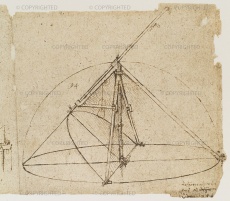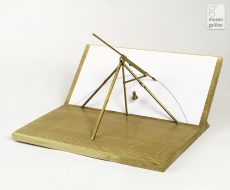Parabolic Compasses
From Inventions
Has no specific name.
Contents |
Inventor
Leonardo da Vinci (1452-1519)
Historic Period
1478-1518
Description
Leonardo’s studies on conic sections are documented in the Codex Arundel on fol. 73r. His main source for these studies was the De rebus Expetendis by Giorgio Valla (Venice 1501), mentioned later in relation to mean proportionals (fols. 178-179). Leonardo’s interest in this sector of geometry stemmed from his research on parabolic burning mirrors. Presumably, the compass drawn on the folio in the Codex Atlanticus was designed expressly for constructing the profile of a centring used to fabricate such mirrors. In structure, the compass is a rectangular cone. The only mobile part is the 45° inclined arm carrying the sliding stylus (generatrix of the cone). A parabola is traced on a sheet of paper placed on the inclined plane that represents the section of the cone parallel to the generatrix. This curve is traced in two steps, starting each time from the top so that, as the compass rotates, the stylus slides downward under the impetus of its own weight. Leonardo apparently considered incrementing this motion by adding a small weight to pull the stylus down as it turned. The compass is probably the instrument that allowed Leonardo to visualize this conic section as a parabola, in contrast to a study in the Codex Arundel (fol. 73r) where the section, constructed by geometric overturning, is erroneously interpreted as the arc of a circle.
Bibliographical Resources
C.A. 394 r-a, Il Codice Atlantico di Leonardo da Vinci, ed. facsimile dopo il restauro dell’originale conservato nella Biblioteca Ambrosiana di Milano, 12 voll., Giunti-Barbéra, Firenze 1973-75.
Camerota, Filippo. Compasso per parabole, in Nel segno di Masaccio. L'invenzione della prospettiva, catalogo della mostra, Firenze, Galleria degli Uffizi (16 ottobre 2001 - 20 gennaio 2002), Giunti, Firenze, 2001, p. 185.
Existing Instruments
Museo Galileo-Istituto di Storia della Scienza, modello funzionante (2001).
Images
Author of the entry: Filippo Camerota


